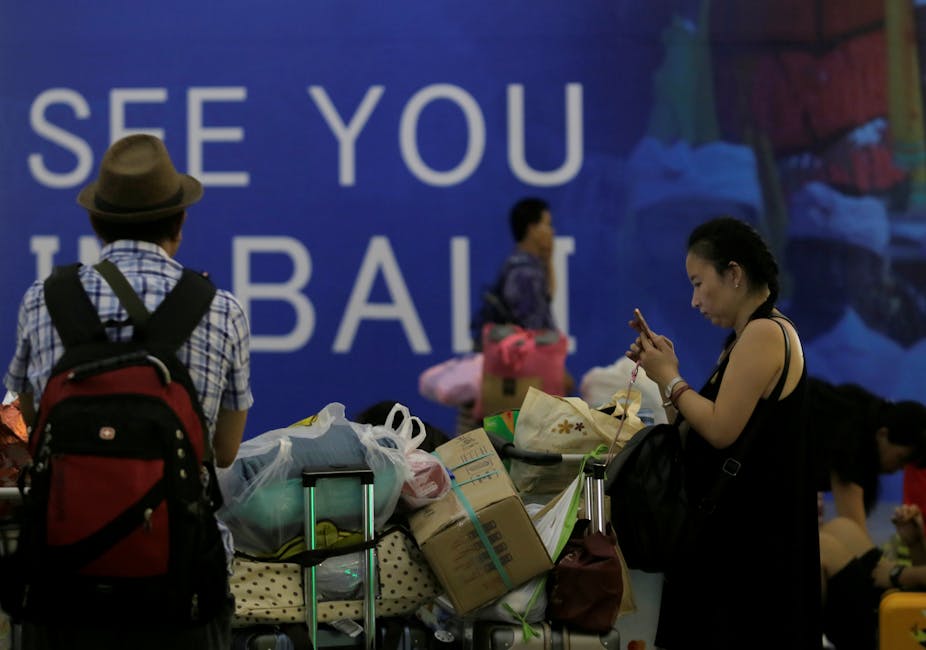Bali’s Mt Agung has been active since September 2017. The intensity of the volcano’s activity increased significantly throughout November until it started spewing smoke and ash on November 21th. However, it was not until November 27th that the Bali Tourism Board published its first updates on the volcano’s activity and its possible impacts on tourists.
Meanwhile, Indonesia’s Disaster Management authorities have issued a high level of alert about Mt Agung for over a month. Many of the international airlines which service Bali have been forced to cancel flights into and out of Bali due to the high level of volcanic ash in the skies over and surrounding Bali.
Passengers stranded
According to media reports, thousands of international and domestic tourists are virtually stranded in Bali awaiting delayed flights out of Bali to international or alternative Indonesian domestic destinations.
Airlines are subject to strict rules related to flying in skies with volcanic ash. The International Civil Aviation Organisation (ICAO), the UN body which governs global airline safety, bans airlines from flying in skies which have a certain level of volcanic ash.
Many airlines enforce stricter rules than the ICAO on flying through volcanic ash. In recent days, Qantas, Japan Airlines, KLM, Jetstar, Air Asia and Virgin Australia are among the airlines which have suspended flights to and from Bali.
Criticism over Bali’s business-as-usual approach
The Bali Tourism Board and the Indonesian Ministry of Tourism came under considerable criticism from the international media and much of the global travel industry for its market driven advice to tourists.
Until its announcement of November 27th, both institutions were informing the travellers they had nothing to worry about from Mt Agung. While it is true that Mt Agung is 70 kilometers away from most of Bali’s popular tourism resorts, it was misleading to suggest the volcano’s increasing activity would have no impact on tourists.
Bali is heavily dependent on the tourist dollar. Over 60% of the Balinese economy and jobs are directly or indirectly dependent on the industry. In 2016 nearly 5 million international tourists visited Bali while domestic tourists could reach 7 million a year. It’s not surprising that for economic reasons, Bali wanted to maintain the flow of visitors.
However, a core principle in risk management are the twin concepts of likelihood and consequence. As most volcanologists recognise, there is now a high likelihood of a major eruption of Mt Agung. The consequences of an eruption would be mass evacuations from the area surrounding the mountain.
Others include poisoning of water supplies, high levels of atmospheric ash, crop damage, and disruption to transport. In addition, the challenge of accommodating local evacuees and stranded visitors would create an emergency management disaster on an epic scale.
Bali’s “business as usual” approach until November 27th was widely regarded as highly irresponsible. To many observers, it appeared that the Balinese tourism industry was more interested in keeping the tourist dollars flowing than in demonstrating any duty of care to tourists.
It is little wonder that many tourists were confused by the mixed messages coming from Indonensia’s tourism ministry and Bali’s tourism board that all was well while airlines and Indonesia’s own disaster management agencies warned of danger.
Long-term reputation more important
Many of the tourists in Bali who have been inconvenienced or stranded have bitterly complained on both social and traditional media platforms. They were critical of the misleading advice they received from travel agents and the Bali Tourism Board, which contradicted that of airlines, government travel advisories and travel insurance companies.
This has impacted on the reputation of the quality and honesty of advice provided to tourists, travel agents and tour operators from both the Indonesian Tourism Ministry and the Bali Tourism Board. The most precious asset any national or local tourism board has is its reputation for honest, accurate and reliable information. This includes providing warnings of potential dangers to tourists and measures that tourists can take to minimise their exposure to those dangers.
Ironically, I was in Bali in May 2017 giving a presentation on this very issue. I spoke at the APEC Counter Terrorism and Tourism Conference, hosted by the government of Indonesia. In fact, my approach to advising government tourism board is to provide due warning to arriving tourists on security related risks (including natural disaters) was adopted as one of the key recommendations to APEC governments as a conference outcome.
The Balinese Tourism Board should learn an important lesson from its misleading messaging in response to Mt Agung. It is better to sacrifice some tourism business in the short term than to permanently damage a good reputation as a reliable and respected provider of destination tourism and marketing information.


